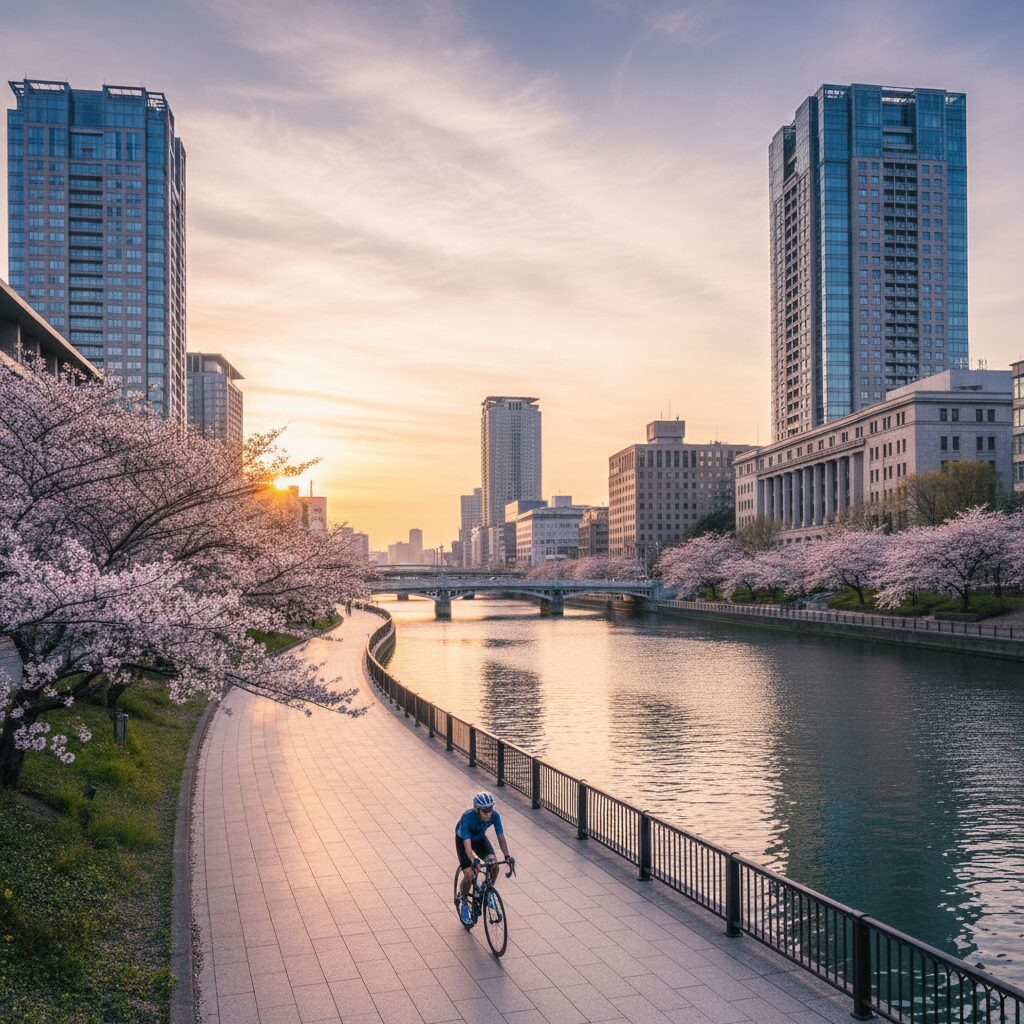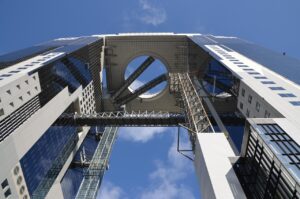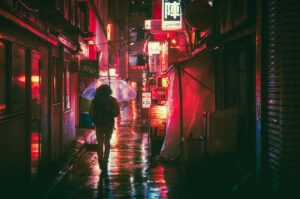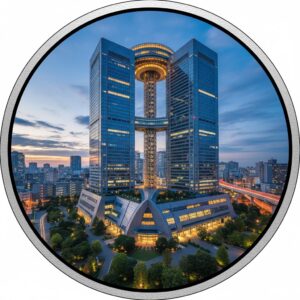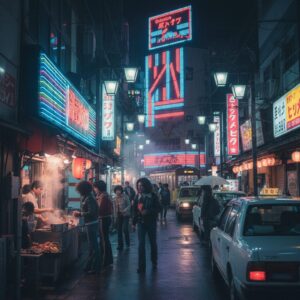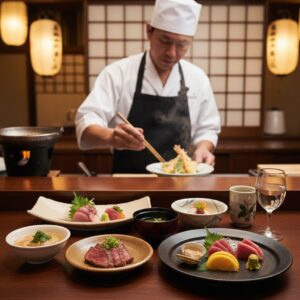There’s a certain kind of magic that lives in the heart of a metropolis, a pulse you can only feel when you slow down and tune in. In Osaka, a city known for its boundless energy, its neon-lit nights, and its culinary soul, that pulse beats strongest on a sliver of land cradled by two gentle rivers. This is Nakanoshima, an island park that serves as the city’s sophisticated, green heart. It’s a place where the steel and glass towers of commerce gaze upon elegant, century-old halls of culture, where manicured rose gardens bloom in the shadow of expressways, and where the gentle flow of water offers a constant, soothing rhythm against the urban hum. To truly understand this beautiful paradox, you can’t just walk it; you need to glide through it. An urban cycling tour of Nakanoshima isn’t just a ride; it’s a rolling conversation with Osaka itself, a journey through its past, present, and future, all unfolding with each turn of the pedal. It’s an experience that reveals the city’s core identity, a place where ambition and artistry, nature and human ingenuity, flow together as seamlessly as the Dojima and Tosabori rivers that define its shores. Forget the crowded subways for a moment. Grab a bicycle, feel the breeze, and let’s explore the soul of the city, one bridge, one building, one blossom at a time.
For a different perspective on the city’s vibrant energy, consider exploring the retro nightlife district of Juso after your ride.
The Journey Begins: Setting the Riverside Rhythm
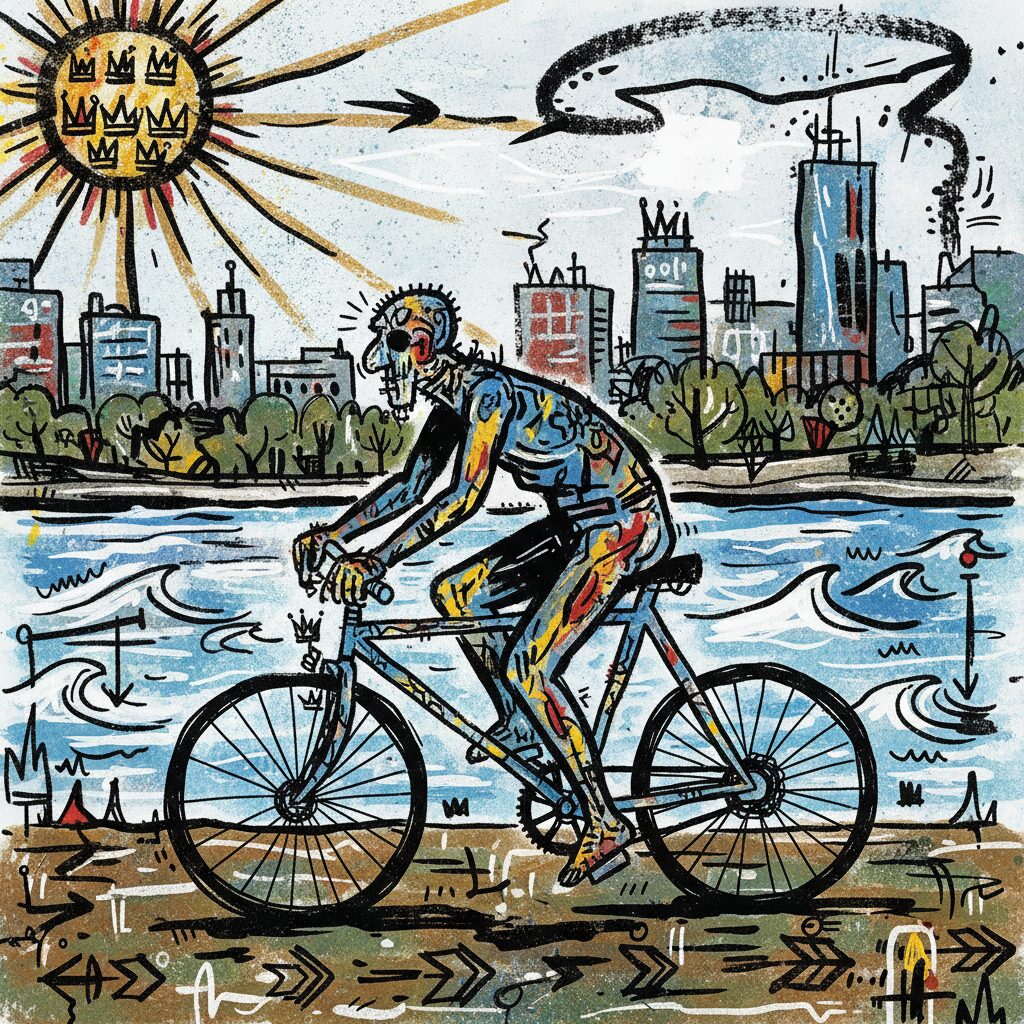
The adventure begins with a simple click and a whir. Finding a ride is woven into the modern urban fabric here; shared bicycle stations are conveniently dotted near train stops like Yodoyabashi and Kitahama. With a quick scan of a QR code on my phone, a sturdy city bike unlocks, and I’m ready to go. The first push of the pedal feels like a pledge, a deliberate choice to sync my rhythm with the city’s. I glide onto the dedicated path that follows the Tosabori River, and instantly, the world shifts. The roar of traffic on the overhead expressway fades into a steady, distant hum, replaced by the soft slap of water against the stone embankment and the rustle of leaves in the Zelkova trees lining the promenade. The air feels different here—cooler, fresher, carrying the subtle, earthy scent of the river. This isn’t just a bike path; it’s a front-row seat to daily life in Osaka. Sleek water taxis, the Aqua-Liners, glide by, their low profiles creating gentle wakes that rock moored private boats. Across the river, the Kitahama district presents a facade of elegant buildings, their ground floors hosting chic cafes with open terraces where people sip coffee, seemingly unaware of the bustling business district just a block away. Ahead, the path stretches, a smooth ribbon of pavement inviting onward. The morning sun, still low in the sky, casts long shadows and makes the river’s surface sparkle as if sprinkled with a million tiny diamonds. Cycling here is meditative. The rhythmic pedal strokes, the steady flow of the river, the vast sky above—it all works together to clear your mind, leaving you open and attentive to the sights and sounds unfolding around you. You’re not merely passing through the landscape; you’re becoming part of its moving tapestry.
Architectural Dialogues: Where Stone and Steel Converse
As you pedal eastward, the scenery begins to shift. The path leads you toward the grand dame of Nakanoshima, the Osaka City Central Public Hall. You sense its presence before you fully see it. It’s an absolute showstopper—a magnificent building of bold red brick and pale granite that seems to have been lifted from a grand European capital and gently set beside the river. Constructed in the early 20th century thanks to the donation of a single stockbroker, this Neo-Renaissance masterpiece, with its dignified arches and striking bronze dome, is more than just a building; it stands as a testament to the civic pride and ambition of Osaka’s merchant class. I often pause here, leaning my bike against a railing, simply to take it all in. The intricate facade, the profound sense of history, the way it commands the landscape—it serves as a powerful anchor to the past. It hosts concerts and lectures, its halls still resonating with the cultural aspirations of a bygone era. It stands in proud, beautiful defiance of the sleek, modern towers rising behind it, creating a visual dialogue that spans a century. Just a stone’s throw away is its equally distinguished neighbor, the Osaka Prefectural Nakanoshima Library. This building is a Baroque dream, with a colonnaded entrance and a heavy, ornate dome sheltering a stunning central hall. It feels like a temple dedicated to knowledge. While the Central Public Hall celebrates public performance, the library invites quiet introspection. A glimpse inside is essential; the warm wood, the soaring celestial ceiling of the main rotunda, and the hushed atmosphere transport you to another era. These two historic gems are the soul of the island. Yet, they remain in constant dialogue with the present. As you cycle, your gaze naturally lifts to the soaring skyscrapers forming the island’s western spine. The Festival Tower complex and gleaming office buildings embody Osaka’s modern economic engine. From your vantage on the bicycle, you can capture the perfect scene: the weathered stone of a century-old library in the foreground, a sliver of blue sky, and the sharp, reflective glass of a 21st-century skyscraper piercing the clouds behind it. This is Nakanoshima’s core story: a seamless, respectful, and breathtakingly beautiful fusion of past and present.
An Oasis of Art and Nature: The Green Heartbeat
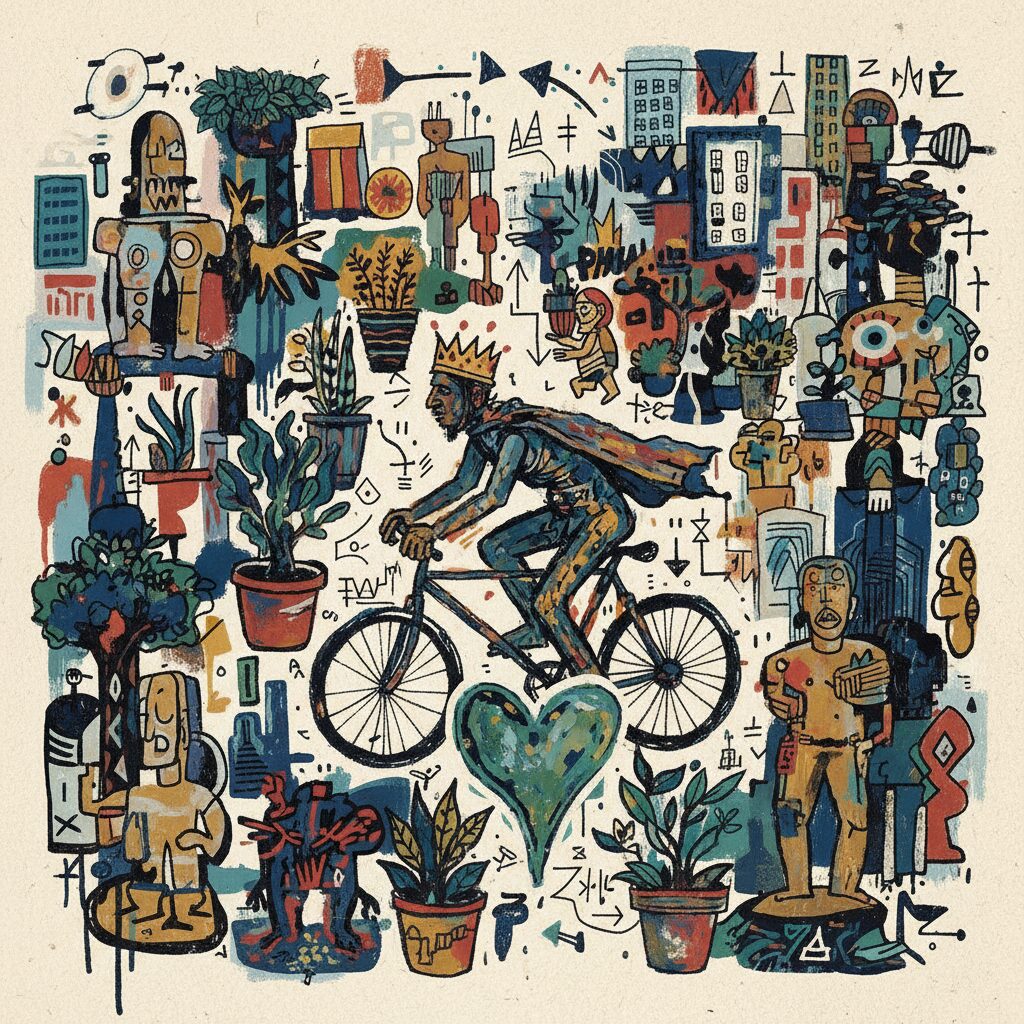
Leaving behind the grandeur of brick and stone, the path leads you into the lush embrace of Nakanoshima Park, Japan’s first public park, opened in 1891. The atmosphere changes again, becoming gentler and more peaceful. Formal promenades give way to expansive lawns and shaded groves. Here, the city feels far removed. Office workers take refuge on benches, sharing lunch and conversation. Elderly couples stroll hand-in-hand beneath dappled sunlight filtering through mature tree canopies. Children chase pigeons near a bubbling fountain, their laughter adding a light, joyful soundtrack to the scene. The park is a living entity, changing its appearance with the seasons. In spring, it erupts in delicate pink and white as cherry blossoms bloom, their petals drifting like snow onto the paths. In autumn, ginkgo and maple leaves turn brilliant gold and crimson, creating a fiery display against the clear blue sky. Yet the park’s crowning jewel is its rose garden. Located near the island’s center, this carefully curated garden hosts over 300 rose varieties. In May and October, at peak bloom, the air fills with their intoxicating fragrance. It’s a sensory delight in the best way. Cycling slowly along the garden’s edge feels like riding through a painting—a blur of reds, pinks, yellows, and whites. It’s a place that invites you to stop, dismount, and walk among the blossoms. Beyond the plants, Nakanoshima also serves as an open-air gallery. As you ride, you’ll encounter various public sculptures and monuments, each with its own story. They add intrigue to your journey, turning a simple bike ride into a treasure hunt for art. This artistic spirit finds its most modern form at the island’s western end. Here stands the remarkable National Museum of Art, Osaka (NMAO). The museum is mostly underground, with only a dramatic, wing-like steel and glass entrance visible at ground level. Designed to evoke the life force of bamboo, it’s a sculpture in its own right—a futuristic gateway to contemporary art below. Next door is the Osaka Science Museum, featuring its giant planetarium dome. This cultural hub makes Nakanoshima a destination not only for relaxation but also for inspiration and intellectual curiosity, a place where you can nourish both soul and mind.
Practical Notes for the Urban Explorer
Setting out on your own Nakanoshima cycling tour is delightfully easy. The city’s bike-sharing system, commonly known as HUBchari, is your trusty companion. Simply download the app, register a payment method, and you can pick up and return bikes at dozens of automated stations throughout the city. Many are conveniently located right at the doorstep of Nakanoshima, near major subway stops like Yodoyabashi, Kitahama, and Higobashi, making access exceptionally straightforward. The full island loop is just a few kilometers long, and the terrain is completely flat, making it suitable for everyone regardless of fitness level. The paths are wide, well-kept, and mostly separate from car traffic, ensuring a safe and enjoyable ride. The best time to embark truly depends on the experience you desire. An early morning ride, as the city awakens, offers a peaceful, nearly private tour. The light is soft and golden, ideal for photography, and the park is calm and reflective. Midday brings more vibrancy, as the park fills with visitors, presenting excellent opportunities for people-watching. My personal favorite, however, is the late afternoon, the “golden hour.” As the sun dips toward the horizon, it casts a warm, magical glow over the entire island. Shadows lengthen, the brick of the Central Public Hall seems to ignite, and the river’s reflections grow deep and rich. This is the perfect time to cross one of the bridges, such as the elegant crystal-arch Naniwabashi Bridge, guarded by its four lion statues, and settle at one of the riverside cafés in Kitahama. From their terraces, you can watch the sunset paint the sky behind the Nakanoshima skyline—a truly unforgettable Osaka moment. As day fades into dusk, don’t rush to leave. The island is about to reveal an entirely new spectacle. The journey is about more than just the destination; it’s about the freedom a bicycle offers. You can stop whenever you like, drawn by a curious sculpture, a striking flower, or the enticing aroma from a nearby coffee shop. This freedom captures the essence of exploring Nakanoshima on two wheels.
Nakanoshima After Dark: A Symphony of Lights
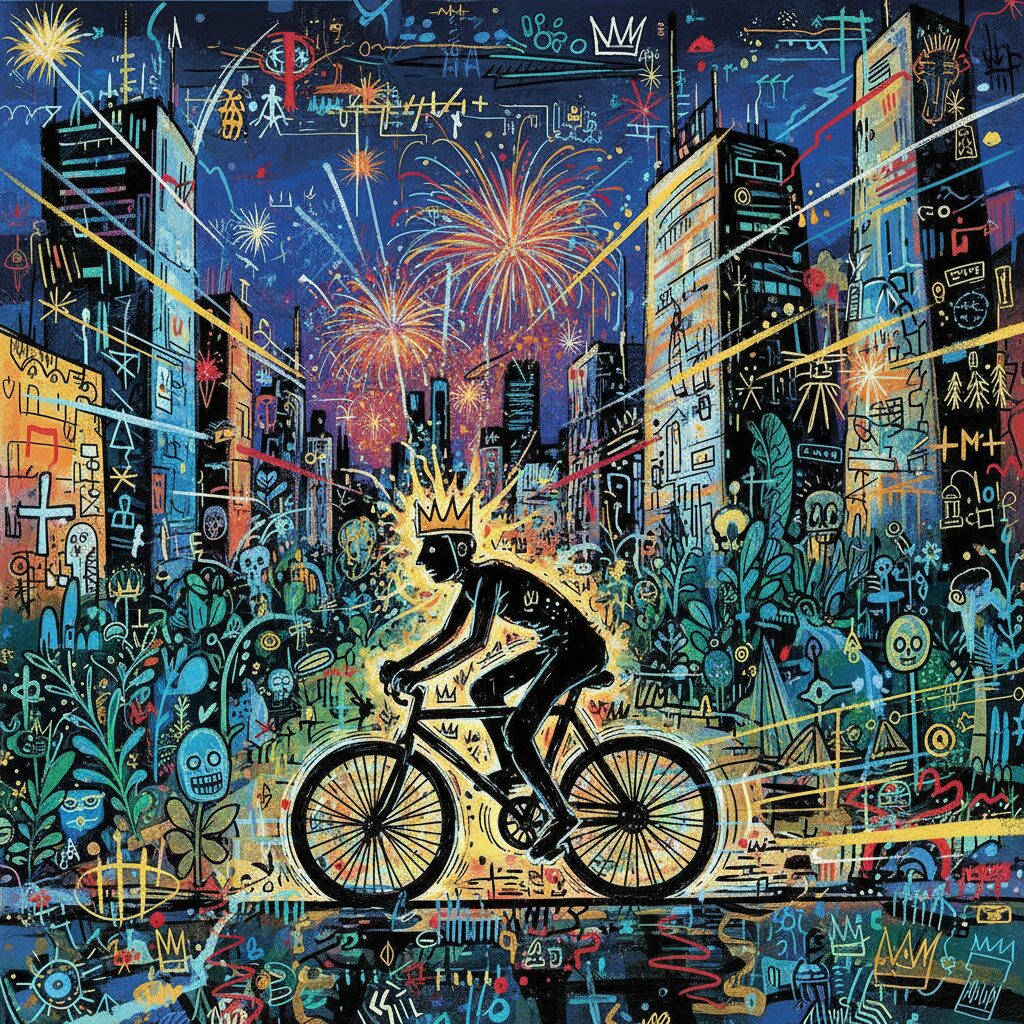
As twilight deepens and the final traces of orange and purple vanish from the sky, Nakanoshima undergoes a breathtaking transformation. The island sheds its daytime identity and embraces a sparkling evening gown of light. A nighttime ride through the park offers a completely different experience—more dramatic, more romantic, and utterly enchanting. The historic buildings are bathed in elegant architectural lighting. The Central Public Hall glows with a warm, dignified radiance, its red bricks acquiring a deeper, richer tone, while the Nakanoshima Library is illuminated to emphasize its classical features, appearing like a floating palace of wisdom. The bridges linking Nakanoshima to the mainland turn into luminous works of art. Their arches, trusses, and even their lion statues are outlined with light, their reflections shimmering and dancing on the dark water beneath. The surrounding skyscrapers, which blend into the background by day, now steal the spotlight. Their countless windows create a vast, twinkling tapestry of light stretching high into the night sky, symbolizing the city’s ceaseless energy. The water taxis, now lit themselves, glide by like friendly river spirits, their lights trailing behind them on the water. Cycling along the riverside paths at this hour feels like stepping into a movie. The contrast between the dark, rustling park trees and the brilliantly lit cityscape is breathtaking. The air is cool, the paths are quieter, and the atmosphere hums with a subtle, electric magic. During winter, this spectacle reaches new heights during the Osaka Festival of Lights. The main promenade transforms into a dazzling tunnel of light, while the facades of historic buildings serve as canvases for stunning projection mapping displays. It’s a city-wide celebration of light and art, with Nakanoshima at its radiant core. A nighttime ride during this period is more than just a cycle; it’s an immersive journey into a festive wonderland, a memory that lingers long after you’ve parked your bike.
Currents of History: The Island That Built a City
To fully appreciate the beauty and significance of Nakanoshima, it helps to understand its rich historical roots. This island was not always a park and cultural center. During the Edo Period (1603–1868), this narrow strip of land was the very heart of Japan’s economy. Osaka was known as the “Tenka no Daidokoro,” or the “Nation’s Kitchen,” because it served as the central hub for distributing rice and other goods from across the country. Feudal lords, or daimyo, from all over Japan maintained massive, fortified warehouses called ‘kurayashiki’ right here along Nakanoshima’s banks. Rice, which functioned as currency at the time, was stored, traded, and valued at the nearby Dojima Rice Exchange. This island was the Wall Street of feudal Japan. The wealth that passed through Nakanoshima funded the city’s growth and nurtured a vibrant culture of merchants, artisans, and entertainers. When you cycle along these riverbanks today, you are retracing the paths where samurai and merchants once walked, where fortunes were won and lost, and where the economic fate of a nation was shaped. The construction of the grand public hall, library, and later the city hall on this very site was no coincidence. It was a deliberate statement—a transformation of the center of commerce into the heart of civic and cultural life, symbolizing Osaka’s evolution into a modern, global city. Understanding this history adds depth to your experience. The gentle lapping of the river feels like a whisper from the past. The grand buildings stand not only as architectural wonders but as monuments to the city’s enduring spirit of enterprise and community. The sleek skyscrapers now serve as modern-day warehouses, storing not rice, but data and capital. The island has never lost its status as the heart of Osaka; it has merely evolved, its purpose shifting from commerce to culture, and from storing goods to preserving the collective memory and aspirations of the city.
A Final Thought on the Flow
A bicycle ride through Nakanoshima is much more than a simple sightseeing tour. It offers an intimate and personal way to connect with the essence of Osaka. It’s about feeling the city’s rhythm in the turning of your pedals, seeing its history reflected in the river, and finding a moment of perfect tranquility amid the vibrant energy of one of Japan’s greatest cities. You’ll leave not only with photographs of stunning buildings and gardens but with a feeling—the sensation of wind on your face, the sound of flowing water beside you, and the sense of having touched the very heart of this dynamic, welcoming, and endlessly fascinating place. So when you visit Osaka, find a bike, follow the river, and let the island of Nakanoshima share its story with you. It’s a story you won’t soon forget.
